Some thoughts and discussions from me.
Yesterday was one of those days where I felt like I ninja kicked it from start to finish. I’m a regular Monday Ninja Warrior. It’s kind of like an American Ninja Warrior, only 97% less bad ass. I mean, I know I wouldn’t want to mess with Kacy Catanzaro.
She may be 5’ and 100 lbs, but she could probably still kick my butt. Just sayin’. I’ll just stick to kicking my to-do list’s butt.
It probably had something to do with having my parents here last week and allowing said list to rival the length of a college physics book, but that’s neither here nor there. I got the first workout of Boot Camp checked off, wrote two new programs for online clients (now accepting clients – 2 spots available FYI!) started an article that’s due this week, cleaned the bathrooms, did the laundry, and went for a run. However, I think my biggest accomplishment was playing human frogger and winning (aka not dying) as I darted across a busy high way to get to a nearby trail.
Success.
I (finally) took a shower after my run and it was then that I realized something happened that just doesn’t happen. But it did: I hadn’t had a drop of coffee yet…and it was almost noon!!
*blinks*
I know, I’m as shocked as you are.
Basically true.
I blame it on a 4 letter acronym I call EPOC, or Excess Post Oxygen Consumption.
Excess Post Oxygen Consumption, AKA Workout After Burn
Yesterday I happened to split up my workouts. I got in about a 40 minute strength sesh first thing in the morning (well, after a bite to eat![]() ) did some work and got some stuff done, and then went on a run a couple hours later. Each workout left me feeling great, thanks to a surge of endorphins, and I didn’t even feel like I needed coffee! Don’t worry, I promptly made a French press full of my favorite local brew, Novo in Denver.
) did some work and got some stuff done, and then went on a run a couple hours later. Each workout left me feeling great, thanks to a surge of endorphins, and I didn’t even feel like I needed coffee! Don’t worry, I promptly made a French press full of my favorite local brew, Novo in Denver.
Anyway, back to EPOC – what is it?
EPOC is basically the physiological effect of what happens to your metabolism after your workout. Basically, after you complete a workout, even though your body is technically resting, your metabolism is still burning energy/calories at a higher rate. Technically, EPOC is the amount of exercise needed to return your body to homeostasis, or its baseline metabolic function.
During exercise, we use up stored and produced (from oxygen exercise) ATP, the body’s fuel used during exercise. When we’re doing aerobic exercise, our bodies can produce and use ATP, and when we’re anaerobic, we don’t have ATP as readily available, and we have to get it after exercise. In sort, EPOC is just one of the ways our body expends energy (aka burns calories.)
Pretty cool, right? But, did you know that EPOC is a pretty fascinating effect, that can actually be increased depending on your workout intensity and type?
5 Ways to Increase EPOC:
1. Increase the intensity.
Workouts done at a higher intensity means your body gets its energy from anerobic energy stores. Since the body uses oxygen after exercise to return to baseline, the body will have to work even harder to do this since during the workout it bypassed aerobic stores (ATP as energy) to an anaerobic state. HIIT has actually been shown to be the most effective way to increase EPOC.
I definitely include some HIIT intervals in my indoor cycling classes! ![]()
Studies show that strength training – especially with heavier weights and compound movements – requires a higher EPOC effect.
3. Decrease rest periods in weight training.
With decreased rest between sets, the body becomes more anaerobic, requiring more energy pathways and thusly, stimulating a higher EPOC effect after exercise.
4. Incorporate alternating upper & lower-body exercises into your workout.
Oxygen + energy is carried by blood, and a working muscle requires oxygen to carry the ATP to that working muscle to fuel it. Switching from upper to lower body movements shunts the blood to different etremeties of the body, which is yet another way to place demand for ATP from anaerobic tracks.
5. Longer doesn’t necessarily mean more after burn.
EPOC is increased when we exercise at higher intensity because we become more anaerobic. When we exercise at longer durations, chances are we’re using more aerobic pathways than anaerobic, meaning our body won’t require as much EPOC to return to homeostasis after exercise.
Other Notes:
-This is most certainly not to say you should only form your workouts around how high your EPOC stimulation will be following the workout. Studies have shown that doing too much HIIT or high intensity exercise can be hard on the body. But it’s certainly something to consider for some workouts, especially if your total calorie burn in the amount of time you have is important to you.
-Make sure you have at least 48 hours of recovery between each HIIT or high intensity workout.
-It’s also important to remember that EPOC doesn’t burn hundreds and hundreds of calories after each workout, but it can last upwards of 10 hours post-workout.
–Fit individuals have a quicker rate of return to metabolic function, meaning a decreased EPOC duration
Does EPOC affect your workouts? Either how you determine them or how you feel afterward?

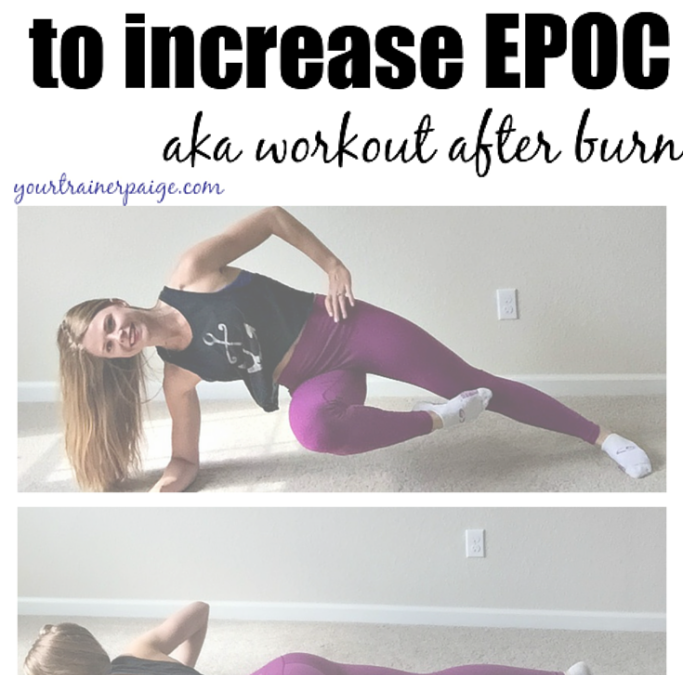
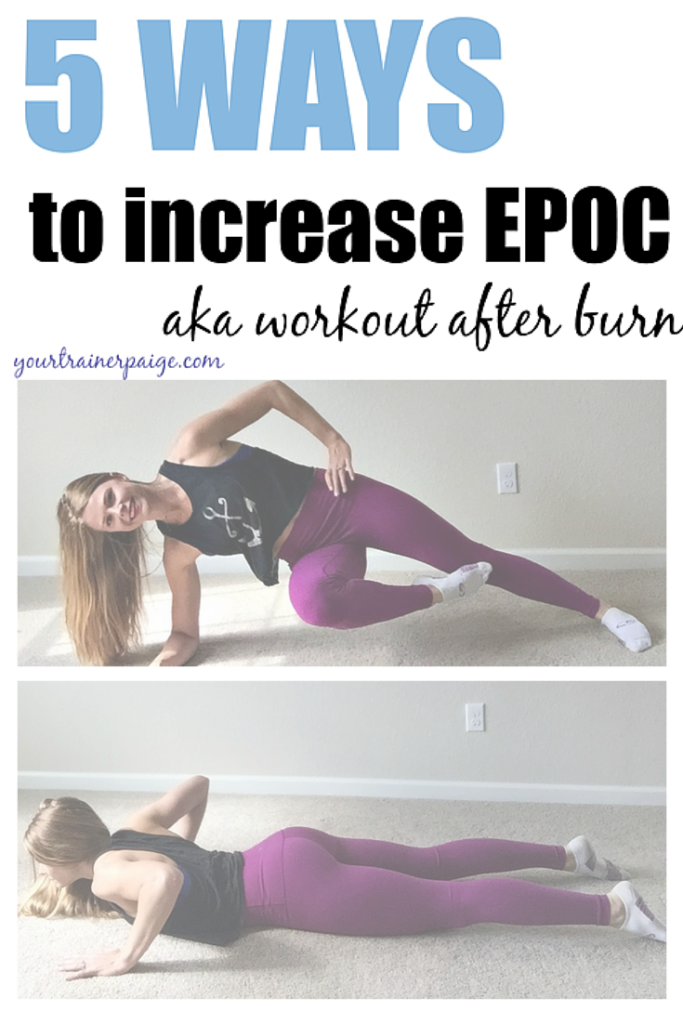



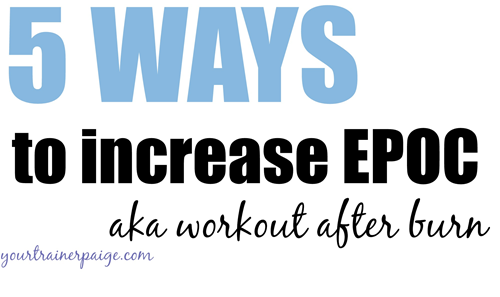

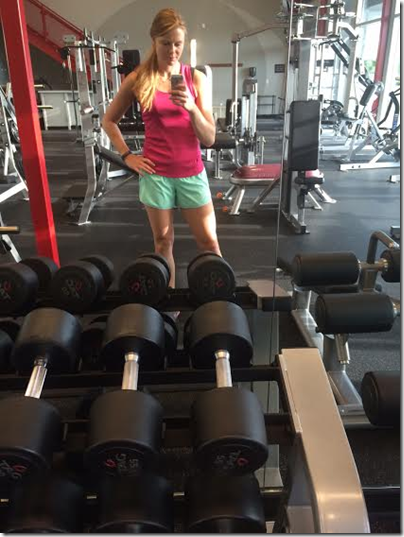
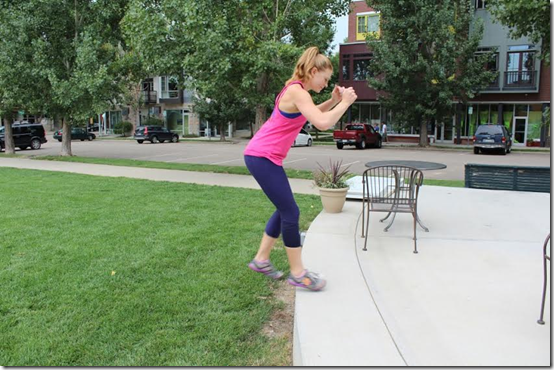
This is exactly what I needed to read this morning – thanks for sharing. I love high intensity and weight training but haven’t thought about combining the upper and lower body or shortening my rest periods to up my after burn. Will start trying this!! 🙂
Sam @ PancakeWarriors recently posted…Peanut Butter Bites and Pumpkin Pie Chickpeas
I’ve been trying really hard to increase my weights in BodyPump and MAN have I been more sore the next day! It’s such a love hate relationship but it let’s me know I’m building muscle and hitting that EPOC stage 🙂
Great post!
Way to go, Fiona!! 🙂
My new year resolution = hit the weight room/get a trainer…. Ha Ha Ha, uhhh new years is not for a little bit, so uhhhh what the heck am I doing from now til then???
GiGi Eats recently posted…Gobble Up These Turbutkles!
I learned a lot! Thanks for this post!
Erin @ Her Heartland Soul recently posted…Fall Fashion Picks
Always good to hear! 🙂
Such an informative post! I loved reading this. As always, thanks for sharing your knowledge with us! I definitely experience some EPOC after my BodyPump classes. I always feel pretty amazing and kick ass after them! I totally owe it to the surge of endorphins and EPOC. I also liked the notes you put at the end about resting and giving your body a chance to recover. I realized after several weeks of subbing way too many BP classes that my body was wiped and not loving the all-the-time high intensity workouts. Lesson learned! Now that I’m doing them only a few times a week, my body is much happier and is feeling the EPOC affects more.
Ashley @ My Food N Fitness Diaries recently posted…Confessions of a Mommy Group Fitness Instructor
I love learning new things. Thanks for sharing this info. It’s nice to know my workouts are paying off even after I’m done them.
Fiona @ Get Fit Fiona recently posted…Yoga Inferno Review
Good post! I like learning about the science of how the body responds to different types of exercise, as well as food/diet. Keep em coming!
Fabu tips!! I’m definitely trying to do more weights for this reason!
Amanda – RunToThefinish recently posted…ChiRunning has it all wrong: Running technique to increase power
Thanks Amanda 🙂 Good for you!!
Thank you for the advice on EPOC!
Thank you EVEN MORE for the Ninja Warrior comparison! Lord know I love those days, and putting a title to them I think will help me have more of them 🙂